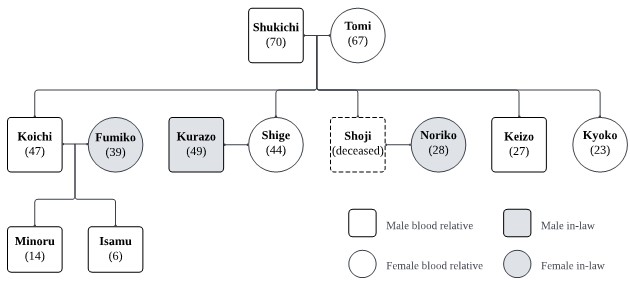Gender- and Age-related Constraints in Japanese Politeness Marking: A Statistical Analysis of the Tokyo Story Characters’ Usage of Keigo
Abstract
This quantitative study explores the relationship between three sociological factors (age, gender and possible in-law relationship) and the use of Japanese honorifics (keigo). Statistical analyses are conducted on the occurrence of Japanese politeness markers found in the script of the movie Tokyo Story directed by Yasujiro Ozu in 1953. Results notably confirm the highly significant correlation between age, gender and the use of keigo, women and younger speakers using consistently more politeness markers than men and older speakers, even though Japanese polite speech does not seem to reflect the order of magnitude derived from the age difference numeric value but only the acknowledgement of one interactant’s seniority.
The study also delves into the distinction between the mere presence of keigo in discourse and its intensity of use in actual speech (i.e. number of politeness markers), revealing complex relationships. For example, same-sex dyads exhibit different patterns of politeness, with men-to-men politeness associated more with the former and women-to-women politeness more with the latter. The interplay between age and gender in keigo use seems to defy systematic rules, highlighting the importance of considering unique gender- and age-based pairings, in other words: distinct categories of address styles that are both interrelated and individual.
Downloads
References
Dixon, R. M. W. (1972). The Dyirbal language of North Queensland. Cambridge, England: Cambridge University. https://doi.org/10.1017/CBO9781139084987
Fukuda, A., & Asato, N. (2004). Universal politeness theory: application to the use of Japanese honorifics. Journal of Pragmatics 36 (pp. 1991-2002). https://doi.org/10.1016/j.pragma.2003.11.006
Holmes, J. (1995). Women, Men and Politeness. Edinburg Gate, England: Pearson Education Limited.
Hori, M. (1986). A Sociolinguistic Analysis of the Japanese Honorifics. Journal of Pragmatics 10 (pp. 373-386). https://doi.org/10.1016/0378-2166(86)90007-X
Ide, S. (1982). Japanese Sociolinguistics Politeness and Women’s Language. Lingua 57 (pp. 357-385). https://doi.org/10.1016/0024-3841(82)90009-2
Ide, S. (1989). Formal forms and discernment: two neglected aspects of universals of linguistic politeness. Multilingua 8(2-3) (pp. 223-248). https://doi.org/10.1515/mult.1989.8.2-3.223
Kogo, N., Yasujiro O. (1953). Tokyo Monogatari (Tokyo Story). Tokyo: Romando Scenario Library. Kindle Edition.
Kuwae, K. (1999). Manuel de japonais, volume 2. Paris : Langues & mondes, l’asiathèque.
Leech, G. (1983). Principles of pragmatics. London: Longman.
Leech, G. (2014). The Pragmatics of Politeness. New York, U.S.: Oxford University Press. https://doi.org/10.1093/acprof:oso/9780195341386.001.0001
Manno, G. (2002). La politesse et l’indirection : un essai de synthèse. Langage et société 100 (pp. 5-47). https://doi.org/10.3917/ls.100.0005
Matsumoto, Y. (1988). Reexamination of the Universality of Face: Politeness Phenomena in Japanese. Journal of Pragmatics 12 (pp. 403-426). https://doi.org/10.1016/0378-2166(88)90003-3
Mizutani, O., & Mizutani, N. (1987). How to Be Polite in Japanese. Tokyo: The Japan Times.
Minegishi Cook, H. (1999). Situational Meanings of Japanese Social Deixis : The Mixed Use of the Masu and Plain Forms. Journal of Linguistic Anthropology 8(1) (pp. 87-110). https://doi.org/10.1525/jlin.1998.8.1.87
Okamoto, S. (1997). Social context, linguistic ideology, and indexal expressions in Japanese. Journal of Pragmatics 28 (pp. 795-817). https://doi.org/10.1016/S0378-2166(97)81491-9
Okamoto, S. (1999). Situated Politeness: Manipulating Honorifics and non-Honorifics Expressions in Japanese Conversations. Pragmatics 9(1) (pp. 51-74). https://doi.org/10.1075/prag.9.1.05oka
Okamoto, S., & Siegal, M. (2003). Toward Reconceptualizing the Teaching and Learning of Gendered Speech Styles in Japanese as a Foreign Language. Japanese Language and Literature 37(1) (pp. 49-66). https://doi.org/10.2307/3594875
Okamoto, S., & Shibamoto-Smith, J. S. (2004). Japanese Language, Gender and Ideology: Cultural Models for Real People. New York, U.S.: Oxford University Press. https://doi.org/10.1093/oso/9780195166170.001.0001
Okamoto, S. (2011). The use and interpretation of addressee honorifics and plain forms in Japanese: Diversity, multiplicity, and ambiguity. Journal of Pragmatics 43 (pp. 3673-3688). https://doi.org/10.1016/j.pragma.2011.06.012
O’Neill, P. G. (1981). A Programmed Course On Respect Language In Modern Japanese. Guildford, Great Britain: Hodder and Stoughton.
Peng, F. et al. (1981). Male/female differences in Japanese. Tokyo: The East-West Sign Language Association.
Shimamori, R. (2001). Grammaire japonaise systématique, Volume II, Les expressions verbales et les expressions de la politesse. Paris: Jean Maisonneuve.
Siegal, M., & Okamoto, S. (2003). Toward Reconceptualizing the Teaching and Learning of Gendered Speech Styles in Japanese as a Foreign Language. Japanese Language and Literature 37 (pp. 49-66). https://doi.org/10.2307/3594875
Smoreda, Z., & Licoppe, C. (2000). Gender-Specific Use of the Domestic Telephone. Social Psychology Quarterly 63(3) (pp. 238-252). https://doi.org/10.2307/2695871
Suzuki, T. (2007). A Pragmatic Approach to the Generation and Gender Gap in Japanese Politeness Strategies. Tokyo, Japan: Hituzi Syobo Publishing.


This work is licensed under a Creative Commons Attribution 4.0 International License.
Copyright for this article is retained by the author(s), with first publication rights granted to the journal.
This is an open-access article distributed under the terms and conditions of the Creative Commons Attribution license (http://creativecommons.org/licenses/by/4.0/).









1.png)









1.png)











